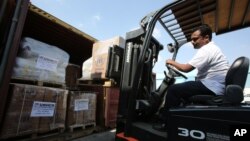DUBAI —
On the dusty outskirts of Dubai, away from the glitzy skyscrapers and bustling highways, lies a collection of warehouses used by the United Nations to assist some of the world’s most impoverished people.
The UNHCR’s emergency relief stockpile in the United Arab Emirates has been operating since 2006, but officials say an unprecedented number of humanitarian emergencies has led to a recent surge in operations.
Today, work at the Dubai facility rarely stops.
UNHCR senior global supply officer Soliman Mohamed Daud said, “This place is really getting bigger in volume. There is really more and more demand from operations around the world requesting core relief items from here.”
During the past two years the amount of cargo handled at the stockpile increased by 100 percent. Last year, 103 shipments were dispatched to more than 36 countries grappling with man-made and natural disasters, up from 22 in 2012.
The emergencies in Syria, Central African Republic and the Philippines all received multiple shipments in the past year.
“Syria by itself, in 2013, 30 percent of what was sent from the Dubai stockpile was sent to Syria [and its neighbors] and that’s almost 20 percent of what was given to the Syria operation,” Daud said.
Dubai stockpile is largest, busiest
Out of the UNHCR’s seven global stockpiles, Dubai has become the largest and busiest due to its strategic location and excellent logistics facilities. Within 72 hours it can serve up to 350,000 people with basic relief items - such as family tents, blankets, kitchen sets and sleeping mats.
UNHCR communications officer Mohammed Abu Asaker said the ability to deliver adequate relief supplies, however, is never guaranteed.
“All the humanitarian items at the Dubai stockpile, and other stockpiles, depend on donations from donors. The biggest constraint that we face is the money and the financial support," said Asaker. "We need the money to buy the humanitarian items, to make sure that we have them available all the time for any emergency.”
Each disaster has its own appeal for aid.
In December, the United Nations announced its largest-ever fundraising drive, seeking $6.5 billion for humanitarian aid to Syria alone. The body estimates that nearly three-quarters of the country’s 22.3 million population will need assistance by the end of the year.
Rising demand
Asaker said the numbers are worrying.
“We are in March already, so far we have only 20 percent available out of this money, so we are short," he said. "So we need and appeal to the international community and to donors to provide financial assistance quickly. This will enable us to respond effectively to the refugees.”
For the time being, the Dubai aid depot copes with the rising demands. Officials at the UNHCR say their dependency on the stockpile undoubtedly will grow in the future.
"We are looking forward to seeing Dubai’s stockpile as the first-line respondent to all emergencies all over the world," Asaker said.
In addition to the UAE, the UNHCR has stockpiles in Kenya, Tanzania, Cameroon, Ghana, Denmark, and Jordan. Together they are able to provide assistance for up to 700,000 people.
The UNHCR’s emergency relief stockpile in the United Arab Emirates has been operating since 2006, but officials say an unprecedented number of humanitarian emergencies has led to a recent surge in operations.
Today, work at the Dubai facility rarely stops.
UNHCR senior global supply officer Soliman Mohamed Daud said, “This place is really getting bigger in volume. There is really more and more demand from operations around the world requesting core relief items from here.”
During the past two years the amount of cargo handled at the stockpile increased by 100 percent. Last year, 103 shipments were dispatched to more than 36 countries grappling with man-made and natural disasters, up from 22 in 2012.
The emergencies in Syria, Central African Republic and the Philippines all received multiple shipments in the past year.
“Syria by itself, in 2013, 30 percent of what was sent from the Dubai stockpile was sent to Syria [and its neighbors] and that’s almost 20 percent of what was given to the Syria operation,” Daud said.
Dubai stockpile is largest, busiest
Out of the UNHCR’s seven global stockpiles, Dubai has become the largest and busiest due to its strategic location and excellent logistics facilities. Within 72 hours it can serve up to 350,000 people with basic relief items - such as family tents, blankets, kitchen sets and sleeping mats.
UNHCR communications officer Mohammed Abu Asaker said the ability to deliver adequate relief supplies, however, is never guaranteed.
“All the humanitarian items at the Dubai stockpile, and other stockpiles, depend on donations from donors. The biggest constraint that we face is the money and the financial support," said Asaker. "We need the money to buy the humanitarian items, to make sure that we have them available all the time for any emergency.”
Each disaster has its own appeal for aid.
In December, the United Nations announced its largest-ever fundraising drive, seeking $6.5 billion for humanitarian aid to Syria alone. The body estimates that nearly three-quarters of the country’s 22.3 million population will need assistance by the end of the year.
Rising demand
Asaker said the numbers are worrying.
“We are in March already, so far we have only 20 percent available out of this money, so we are short," he said. "So we need and appeal to the international community and to donors to provide financial assistance quickly. This will enable us to respond effectively to the refugees.”
For the time being, the Dubai aid depot copes with the rising demands. Officials at the UNHCR say their dependency on the stockpile undoubtedly will grow in the future.
"We are looking forward to seeing Dubai’s stockpile as the first-line respondent to all emergencies all over the world," Asaker said.
In addition to the UAE, the UNHCR has stockpiles in Kenya, Tanzania, Cameroon, Ghana, Denmark, and Jordan. Together they are able to provide assistance for up to 700,000 people.








